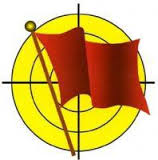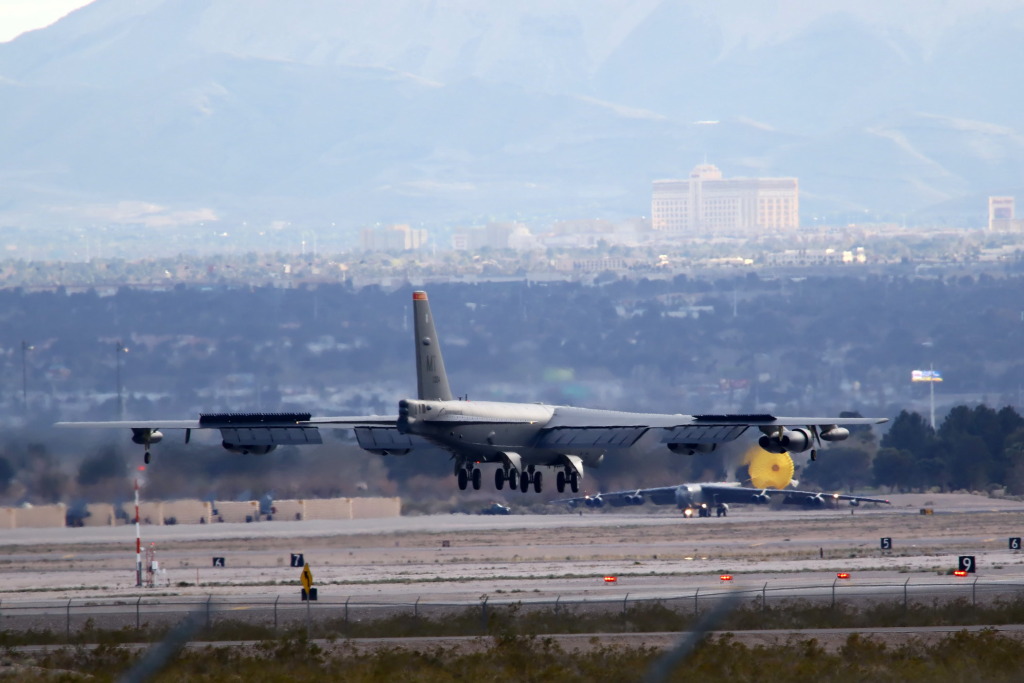|
Red Flag 2015-2
Karo-Aviation visit Nellis airbase for
Red Flag 2015-2
Article and pictures by Ronald de Roij
In addition to the
variety of USAF squadrons, the air combat exercise held March 2 to 13,
2015 out of Nellis AFB, Las Vegas, Nevada featured international
participation by a NATO E-3, F-16s from the Royal Norwegian Air Force,
Mirage 2000s from the United Arab Emirates and
F-16CMs from Aviano Air Base, Italy.
Beyond what was seen, multiple off
site participants were involved virtually in the exercise.

|
A colourful F-16C Aggressor of the 64th Aggressor
Squadron banks for the landing at Nellis Air Force base. The
F-16 will be the sole Aggressor aircraft at Nellis after the
65th Aggressor Squadron was disbanded in 2014.
|
Most virtual
participants were housed in simulators out of Kirtland AFB, New Mexico
and included a complete JSTARs crew sending virtual ground target
information that aircrews responded too.
This combination of Red Flag and Virtual Flag was a first, and is
described as the USAFs LVC (Live-Virtual-Constructive) training. The
Live and Virtual not only reduces the cost of the exercise it increases
the participation, scope and complexity.
Red
Flag
 Red
Flag, a realistic combat training exercise involving the air forces of
the United States and its allies, is coordinated at Nellis Air Force
Base, Nev., and conducted on the vast bombing and gunnery ranges of the
Nevada Test and Training Range. It is one of a series of advanced
training programs administered by the United States Air Force Warfare Center and Nellis and executed through the 414th Combat Training
Squadron. Red
Flag, a realistic combat training exercise involving the air forces of
the United States and its allies, is coordinated at Nellis Air Force
Base, Nev., and conducted on the vast bombing and gunnery ranges of the
Nevada Test and Training Range. It is one of a series of advanced
training programs administered by the United States Air Force Warfare Center and Nellis and executed through the 414th Combat Training
Squadron.
It was established in 1975 as one of the initiatives directed by General
Robert J. Dixon, then commander of Tactical Air Command, to better
prepare our forces for combat after the lessons learned in Vietnam.
Aircraft and personnel deploy to Nellis for Red
Flag under the Air
Expeditionary Force concept and make up the exercise's "Blue" forces. By
working together, these Blue forces are able to utilize the diverse
capabilities of their aircraft to execute specific missions, such as air
interdiction, combat search and rescue, close air support, dynamic
targeting and defensive counter air. These forces use various tactics to
attack NTTR targets such as mock airfields, vehicle convoys, tanks,
parked aircraft, bunkered defensive positions and missile sites. These
targets are defended by a variety of simulated "Red" force ground and
air threats to give participant aircrews the most realistic combat
training possible.
The Red force threats are aligned under the 57th Adversary Tactics
Group, which controls the squadrons of USAF Aggressors, including
fighter, space, information operations and air defense units. The
Aggressors are specially trained to replicate the tactics and techniques
of potential adversaries and provide a scalable threat presentation to
Blue forces which aids in achieving the desired learning outcomes for
each mission.

|
The B-52 was introduced in 1955, and is still used by the US Air force, and is expected to remain in use to the 2040s
.
One landing and a other displaying its bright yellow 40 foot diameter drag parachute.
|
 Each
Red Flag has its own flavour, and in this case it was of interest to
note that no F-22s were involved, and three US Army Patriot batteries
were deployed on the range as part of the Blue Force, with more units
deployed “virtually.” Each
Red Flag has its own flavour, and in this case it was of interest to
note that no F-22s were involved, and three US Army Patriot batteries
were deployed on the range as part of the Blue Force, with more units
deployed “virtually.”
Red Air continues to evolve, with Red Flag 2015-1 featuring F-15E Strike
Eagles on Red Air strike missions, and 2015-2 featuring T-38s flying Red
Air missions, as well as select missions flown by the B1-B and EA-6B on
Red Air. It is anticipated that a Red Air will continue to be
supplemented with various active units moving forward. These units will
not be required to learn “Red Air” tactics as such, but will be given
familiar mission profiles to complete within the context of representing
Red Air. For those who have enjoyed the F-15Cs with their colourful
Aggressor paint, this was the final Red Flag that the F-15C is utilized
in the Red Air Aggressor role.
The action is certainly not limited to air-to-air and air-to-ground
combat units. The 38th Rescue Squadron participated in the missions with
the HH-60G, and HC-130. In what is typically seen as a rescue role
to encompass a much broader mission set of Prepare, Locate, Support and
Recover.
Tactics continue to evolve, and participants must be calculated and wary
about their approach to unfolding situations. A solo F-16C Aggressor was
recently “captured” fast and low on the “Blue side” of the range, and it
was noted that the aircraft was trying to lure Blue Air into a pursuit
to lead them subsequently into a Red Air ambush. Not simply a scripted
exercise, innovative, dynamic activity challenges reactions and creates
tremendous learning experiences in a safe environment.
Each day hosts a unique scenario, perhaps a response to an international
Superpower that seizes a small neighbouring nation, defending an attack,
addressing a hostage situation, or localized regional conflict initiated
by a rogue nation. In any case, the exercises represent the reality of
the world that confronts us today.
United Arab Emirates
The United Arab
Emirates Air Force participated with four single-seat Mirage 2000-9EADs
and a pair of two-seat Mirage 2000-9s from Al Dhafra Air Base. The
United Arab Emirates Air Force has 36 multirole Mirage 2000 fighters
that have been in service since 1986, 30 of which have been extensively
refurbished and then upgraded to the same standard as the newer fleet of
32 Mirage 2000-9s delivered starting in 2003 by France's Dassault
Aviation.
The United Arab Emirates Air Force bought the Mirage 2000-9, as it was
offered with a variant of the Storm Shadow cruise missile, a more
advanced weapon than the U.S. allowed it at the time.
At the core of the Mirage 2000-9's navigation and attack system is a
Thales- and Dassault-developed modular data-processing unit similar to
the one used in the Rafale. This serves as the mission computer, manages
the navigation and attack system, controls the cockpit display system
and generates symbology for the head-up and head-down displays. As a
result, the Mirage 2000-9 is claimed to enjoy a world-beating, highly
intuitive man-machine interface.
The Mirage 2000-9s supported the NATO-led efforts over Libya in 2011, at
first flying air-superiority sorties, before flying air-to-ground
missions.

|
Six United Arab Emirates Mirage 2000 fighter jets participated in Red Flag 13-2 held at Nellis AFB
.
After the Red Flag exercise these aircraft participated in
the following Green Flag.
|
Exercises such as
Red Flag bear a close resemblance to the way modern conflicts are
addressed, as coalitions involving integration of a broad number of
specialized and international assets. In such cases Red Flag training is
critical to prepare for such real world deployments.
The objective of Red Flag has been to provide participants with 10
“combat mission” experiences before entering combat, and as such greatly
increase the performance and survivability of participants. This
approach has demonstrated tremendous success in ensuring US and
coalition forces are the best trained, most prepared military forces on
the planet.
|